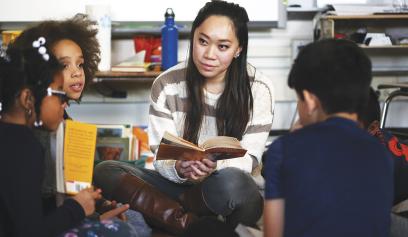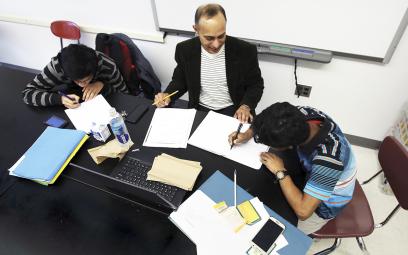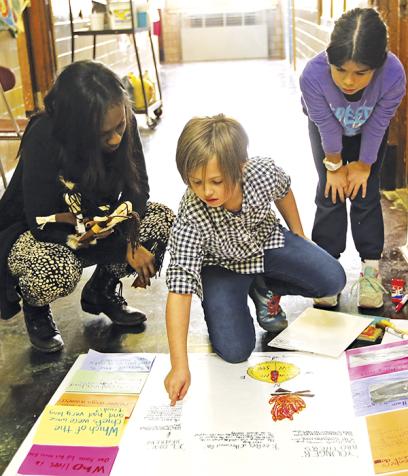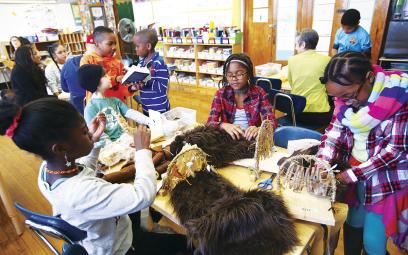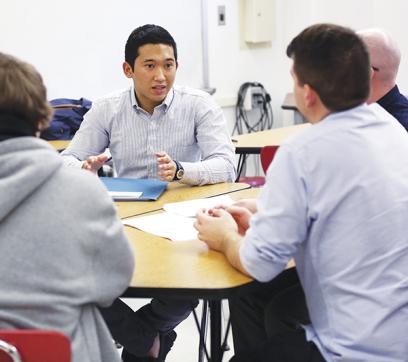“Where do you see your school in five years?” The question took Nancy Salomon Miranda, a fifth-grade teacher at the Brooklyn New School, by surprise. Nearly two years ago, she and her colleagues were attending a meeting at the headquarters of the United Federation of Teachers (UFT) to discuss a new program that the union had negotiated with the New York City Department of Education.
The program, Progressive Redesign Opportunity Schools for Excellence (PROSE), was created to encourage schools like the Brooklyn New School to replicate and build on some of the best practices they had spent years putting in place: shared decision making, classroom visits by peers seeking to improve, scheduling changes to allow for more planning time and in-depth student work, and support for diversity in student enrollment. At the time of this meeting at the UFT, the Brooklyn New School was considering applying to the PROSE program, which the UFT and the city’s Education Department had created in 2014.
Salomon Miranda recalls that she and her peers thought for a minute before answering the speaker’s question about their elementary school. Then they started talking. “Let’s really do something wild and crazy,” she recalls them saying. “Why don’t we have a performance-based assessment?”
Performance-based assessments* are essays, research papers, science experiments, and high-level math problems that the New York Performance Standards Consortium, a coalition of about 40 public high schools, uses to engage students and measure their knowledge and skills in a deep and meaningful way over time. Salomon Miranda and her colleagues’ flash of insight was that elementary school students could demonstrate their learning through performance-based assessments, too. Years ago, when her own children had attended a consortium high school, Salomon Miranda had seen firsthand how performance-based assessments challenged them in a way that standardized tests did not.
Two years after that initial meeting with the UFT, the Brooklyn New School is now using performance-based assessments to assess what third-, fourth-, and fifth-graders know and can do. Thanks to pitching the idea in its PROSE application—and as a direct result of collaboration between the teachers and administrators—it’s now one of the first elementary schools in New York to engage students in performance-based learning modeled on the consortium’s work.
The idea for PROSE, in which more than 140 schools currently participate, came from UFT President Michael Mulgrew. The program provides a structure to enable schools with a proven record of collaboration between teachers and administrators, like the Brooklyn New School, to make changes outside of the contract and regulations to support student learning and teacher development.
To participate, a school’s leadership team of teachers and administrators submits a plan to a PROSE panel made up of equal numbers of members from the union and from management. While plans can focus on almost any aspect of the school’s day-to-day routines, many PROSE schools have focused on one of these five areas: distributed leadership structures; expanded learning time; support for increased diversity in student enrollment; teachers visiting the classrooms of their peers; and innovative scheduling that allows for flexible student grouping (for example, seminars, interdisciplinary projects, and remediation) during the school day.
At a time when the charter sector is viewed by many as a panacea for public education, and when the U.S. president is poised to revive a dubious school voucher experiment, New York City is very publicly promoting some of its successful public schools by ensconcing their practices in a contract so that others will not only take note but follow suit. With PROSE, “there’s a recognition that you do a hard job,” Mulgrew says. “A lot of teachers don’t want people coming into our buildings telling us they’re going to save us. We’re here doing the work. We’ll figure these things out.”
For teachers and administrators at the Brooklyn New School, PROSE has been a way to showcase how student excellence can be achieved within the public school system. And it is being done through labor-management collaboration.†
A Detailed Plan to Support Teaching
In New York City, which has the largest school district in the country, there are 1,700 public schools—and one contract for all of them. Often, schools want to make changes to the contract on a limited set of topics, a practice the district has long allowed. For instance, schools can request a change in the dates of parent-teacher conferences or an adjustment of school start times that are outlined in the contract by submitting a “school-based option,” commonly referred to as an SBO. An SBO can only be adopted if at least 55 percent of UFT members at a school vote in favor of the change, which then goes into effect for one school year. To maintain an SBO, schools must vote every year.
With PROSE, the union has taken the SBO process and “put it on steroids,” Mulgrew says. To that end, applying to be part of PROSE typically unfolds like this: a UFT chapter leader approaches his or her administrators about the program and explains how it allows schools to make innovative changes to the contract to support teaching and learning.
If the administrators agree the school should participate in PROSE, the school’s leadership team, made up of administrators, the UFT chapter leader, and other teachers, crafts a proposal with input from the rest of the faculty. The plan is reviewed by the PROSE panel against a rubric that assesses five key traits, including the plan’s degree of innovation, the school’s level of collaboration, and the extent to which the plan was generated by and with teachers. If the school’s plan is approved, the panel works with the school’s team to refine the plan and prepare it for a vote. At least 65 percent of UFT members at the school then must vote for the plan before the school is accepted into PROSE for a five-year term. Because the PROSE plan lasts for five years, schools do not take a new vote each year, as they do for SBOs.
Given that educational ideas, like administrators, tend to come and go, five years can seem like an eternity. But the time enables schools to see if their proposals will work as planned. And if principals leave during the five-year term, PROSE offers schools some stability, since a new principal cannot change the PROSE plan once it’s in place.
Schools, on the other hand, aren’t locked into something that doesn’t work. If, during the five-year term, a school’s PROSE leadership team finds the plan isn’t taking shape as expected, the team can contact the PROSE panel and tweak the plan.
Unlike an SBO, a PROSE plan must detail how changes will support teaching and learning. “We’re really encouraging schools to be more thoughtful” and “to share that thinking with us so that other schools could benefit,” says Jackie Bennett, assistant to the president at the UFT. PROSE “really only works in schools where everybody is working together.”
When the UFT created the PROSE program, Mulgrew specifically had successful schools in mind. He wanted to give them the recognition they deserved and the support to take their effective practices to the next level. Just as important, he wanted other schools to learn from and model their efforts on the work of these already high-functioning schools. That’s why, as part of PROSE, a PROSE Pathways program enables schools to observe and learn from PROSE schools to help them craft successful PROSE applications.
The successful schools Mulgrew sought to highlight included those in the Internationals Network for Public Schools, a group of 15 high schools in New York City (in addition to 12 schools and academies elsewhere in New York state and in other states) that serve only English language learners; schools in the New York Performance Standards Consortium; and a handful of schools that have long succeeded in making their student bodies socioeconomically diverse.
During contract negotiations, Mulgrew recalls telling city Education Department officials that the district could learn from schools that were known for high levels of collaboration, teacher voice, and student achievement but that had not been celebrated by the previous mayoral administration of Michael Bloomberg, which strictly focused on accountability through test scores and publicly derided collaboration. Joel Klein, who served as schools chancellor under Bloomberg, famously wrote that “collaboration is the elixir of the status-quo crowd.”1 His words revealed the administration’s utter contempt for the teaching profession, the union, and public education.
In fact, schools in the New York Performance Standards Consortium and the Internationals Network for Public Schools, in particular, had often come under attack from past state commissioners of education who advocated a one-size-fits-all approach to curriculum, instruction, and assessment. (In consortium schools, students participate in performance-based assessment tasks in lieu of four out of the five Regents exams mandated for high school graduation; students must still take the Regents exam in English language arts.)
Two years ago, however, with Mayor Bill de Blasio in office and Schools Chancellor Carmen Fariña leading the city’s Education Department, the climate began to change. “Under this administration, we’re moving back to a place where teachers are valued,” says Kamar Samuels, executive director of the department’s Office of School Design and a member of the labor-management PROSE panel. “We believe in teacher voice and professionalism.”
With PROSE, that belief now extends to teacher evaluation. In New York City, teachers select from one of four options for observations that are part of their annual evaluation. In PROSE schools, teachers can select a fifth option, Option PROSE, in which teachers define an area of focus, create a plan, and implement it throughout the year. Often, the plan includes classroom visits with colleagues, and teachers frequently work together on the same area of focus and share their work. At the end of the year, they participate in a structured review of the year’s activity with their principal. In many cases, colleagues are part of that final, summative discussion.
Ultimately, Option PROSE enables “teachers to talk about their practice together” and “share units of lesson plans,” says the UFT’s Bennett. “It encourages all of these really good practices that are collaborative and that move schools forward,” she says, as opposed to a principal just saying “I observed you, and here’s what I think, and here is your score.”
The success of PROSE has also helped lay the groundwork for the district’s most recent move further away from using standardized test scores to evaluate teachers. In December, the UFT and the city agreed that evaluations of teachers at all schools will rely more on student work, including performance-based assessments. At a press conference with department officials announcing the change, Mulgrew said, “This is the first time where I can stand here before you and say we are moving in a better direction.”2
Celebrating a Team Approach
Perhaps the best way to understand what PROSE has enabled schools to do is to look closely at two of them: the Brooklyn New School and the International High School at LaGuardia Community College (IHS).
At IHS, collaboration has been a hallmark of its work since the school’s founding in 1985. Located in Long Island City in Queens, IHS sits on the campus of LaGuardia Community College and enrolls more than 500 students in grades 9 through 12. After graduating, students can remain for a fifth year to take college classes at LaGuardia and still receive guidance and instructional support from IHS teachers.
IHS only accepts beginner- to intermediate-level English language learners who have been in the United States no more than four years at the time they enroll. Currently, IHS students come from more than 50 countries. Although teachers primarily use English, collaborative groups of students work bilingually and students also receive materials and support in their native language. At IHS, all students receive free lunch because such a high percentage of students qualify for it.
Despite the fact that many students enter IHS below grade level, the school does an extraordinary job of helping them become fluent in English and achieve academically. In 2016, the school’s graduation rate was 89 percent, compared with the district’s graduation rate of 72.6 percent.
Jaclyn Valane, the school’s principal, attributes that success to IHS fostering students’ sense of belonging. On their very first day of school, students “see they’re part of this community of learners built for them,” she says. “They’re not a pulled-out section of the school who are the English language learners. Everything that we do here in every way is for students who are immigrants.”
To ensure that educators meet students’ needs, the school has always engaged in distributed leadership, which fosters communication between administrators and teachers and also enables consensus building. In fact, distributed leadership prompted IHS to become a PROSE school in the first place.
When Ernesto Vargas, a social studies teacher at IHS and the school’s UFT chapter leader, initially told colleagues about the PROSE program, the decision to apply and be recognized as a model of what works was an easy one that the entire staff—not just the principal—made together. That’s because, at IHS, teachers have a real voice in decision making.
For years, teachers have sat on and even chaired a number of committees to help run the school. Notably, IHS administrators serve with teachers on only two of the seven committees (the steering committee and the coordinating council); other committees are strictly teacher led. To serve on and chair any committee, teachers are elected by their peers.
“There’s a sense of empowerment with this, just because you’re involved in the day-to-day and the year-to-year operations,” says Steven Dawson, a history teacher and the school’s teacher leader (another democratically elected position at the school). “You aren’t just told what to do.”
Unlike many schools, IHS has a teacher personnel committee, which takes the lead in hiring. When the school must fill open positions, the committee solicits applications, interviews candidates, and makes suggestions to the principal, who then meets with the candidates herself and signs off on the committee’s recommendations.
To faculty at IHS, the idea that teachers have a say in this process makes perfect sense. The school’s founders “very much felt that the people who were working with each other should be hiring each other,” says Allison McCluer, a guidance counselor and a member of the personnel committee, who has worked at the school for 28 years.
Vargas acknowledges that such an idea was unheard of at his previous school. “You didn’t know who was going to be hired,” he says. “You just walked in in September and you’d find out who’s there.”
Before the Bloomberg and Klein era, collaboration around hiring was actually written into the teachers’ contract as an option for all New York City schools. Known as the SBO staffing and transfer plan, it gave teachers a voice in hiring at their schools. But in a major loss for teacher professionalism, Klein curtailed the option so that only principals had the power to hire teachers. However, IHS was able to continue involving teachers when bringing on new staff, just as it had always done, since its shared leadership structures, which ultimately became part of its PROSE plan, made collaboration in all areas, including hiring, one of its core principles.
The constant communication between colleagues at IHS has also helped them focus on students. Among the results of the school’s collaborative work is an innovative schedule that was ultimately affirmed through PROSE. The school operates a block schedule, with 70-minute periods that give students large chunks of time to prepare portfolios for their performance-based assessment tasks. As part of the New York Performance Standards Consortium, the school has long relied on performance-based assessment tasks to engage students in their learning.
The scheduling flexibility also enables teachers to meet in grade-level interdisciplinary teams twice a week. At one such meeting on a November morning, it’s clear just how well members of a joint 11th- and 12th-grade team know their students. The six classroom teachers and one paraprofessional on this team sit around a table, while one teacher with a laptop types notes that appear on a screen at the front of the room:
“Theon [a guidance counselor] and Melissa [a student] are going to SUNY Purchase.”
“College Access fair for black and Latino students.”
“Ivan’s POSSE application is due Thursday.”
The group then discusses students who are struggling. When someone mentions one girl who is avoiding working on her portfolio during the last class period, English teacher Amy Burrous suggests a colleague help the student work on it during a block period in the middle of the day.
A few minutes later, the group discusses how best to support a pregnant student, whose attendance has been spotty. The student has been making progress on a research paper and needs guidance in how to bring that research together. One teacher says if he can convince her to maintain her school attendance, he can work with her and help her see that she can complete the paper and submit it before her baby is due.
“Has anything happened with them in couple’s counseling?” another teacher asks about the student and her boyfriend, who also attends IHS. “No,” a colleague answers. “They’re resistant.” The group then decides to keep trying to convince them to seek help.
The attention that IHS pays to students’ social and emotional needs, in addition to their academic work, is apparent in surveys the school administers at the end of the year. “When you ask students in this school how many adults they feel connected to, it’s often three or four,” says Dan Kaplan, the early college coordinator, who’s worked at IHS for more than 20 years. Because students’ academic success depends in part on their connections with educators,‡ Kaplan says students’ survey responses are a moving testament to the effectiveness of the school’s team-based culture.
That culture also values teacher learning as much as student learning. Just as students present portfolios to move from one grade to the next, teachers must also submit portfolios of their work. Professional development for creating these portfolios is among the minor scheduling changes outlined in the school’s PROSE proposal. Thanks to the program, IHS can schedule professional development time differently from the Education Department’s calendar so that it aligns with the school’s performance assessment system, “but with the same number of [professional development] days, or more, established by the contract.”
IHS is also one of the many schools to use Option PROSE for teacher evaluation. Before PROSE, teachers at IHS had begun working with their colleagues on reviewing their own growth over time, and that team approach continues today.
IHS assigns teachers to four-person teams that include one member they select themselves. Each teacher submits a teaching goal and a plan for achieving that goal to his or her team, plus a self-reflection, which can take the form of an essay or several journal entries. Even the school’s principal and assistant principal are not exempt from this process; they too submit portfolios of their work.
After reading portfolios and visiting classrooms, the peer team meets with the teacher being evaluated for a two-hour conversation about his or her progress. Then the principal meets with the teacher and members of the team to review areas where the teacher can continue to improve. “At its best, it’s celebratory,” says Amy Burrous. But, just as important, it also helps the school put supports in place if a teacher is struggling.
Before PROSE, teachers at IHS found this peer-to-peer feedback and the classroom visits so valuable they would engage in them—and the extra work they entailed—in addition to the evaluation the school district officially required. But now, as a PROSE school using Option PROSE, its peer team assessment approach counts toward teachers’ official evaluations.
Valane, the principal, says such an evaluation is far more meaningful than if she were to observe a teacher’s classroom for 15 minutes twice each year and fill out a checklist of what the teacher did or did not do. “It’s actually the teacher taking months to put together this portfolio and really looking deeply at what he or she wants to grow in,” she says. The process also enables teachers and administrators to “solidify our feedback as a whole.”
That team approach garnered the school an Innovation in Education award from the UFT during its annual Teacher Union Day celebration in November. Valane says that though staff members at IHS were honored to have their work acknowledged as exemplary, to them it hardly felt new. “We have always been about teachers and administrators working together because that’s also a good school.”
A Meaningful Way to Assess Learning
PROSE has enabled some elementary schools, such as the Brooklyn New School, to return to their roots as places that prioritize project-based learning and student diversity. Founded in 1987 by a group of parents and teachers, the school in Carroll Gardens is just down the street from the quintessential brownstones that the neighborhood is known for.
According to Anna Allanbrook, the school’s principal, the Brooklyn New School joined PROSE to push back against teacher evaluation tied to student test scores. In recent years, around 95 percent of the school’s students in third through fifth grades have opted out of taking standardized tests.
In their place, the school has focused on creating performance-based assessments for these grades, often referred to as the testing grades. Establishing the scheduling flexibility to create and administer such assessments figured prominently in the school’s PROSE proposal. It requested and was granted changes to the number of attendance days for its more than 600 students and changes to the end-time of school days once each month so that teachers could engage in professional development geared toward performance assessments.
In its PROSE proposal, the Brooklyn New School also stated its commitment to maintaining a diverse student population. “Our children don’t come from the neighborhood,” Allanbrook says. “They’re actually admitted by lottery.”
When the school was founded, nearly 50 percent of students qualified for free or reduced-price meals. Today, that figure is a little under 30 percent. Since the Supreme Court’s 2007 ruling against the use of race in public school admissions, the Brooklyn New School has struggled to ensure it enrolls students from all walks of life. But thanks to PROSE and the district’s new Diversity in Admissions pilot program, it is now among a handful of schools allowed to give priority to low-income students. For instance, this year, after siblings and pre-K students, the school was able to give priority to students eligible for free or reduced-price meals. In September, it admitted a kindergarten class made up of 52 percent of students from low-income families, compared with 20 percent the previous year.
Fifth-grade teacher Nancy Salomon Miranda says the performance-based assessments were a natural outgrowth of the school’s teaching and learning philosophy. For years, its students would focus on grade-level projects—studying China in third grade, New Amsterdam in fourth grade, and Mayan culture in fifth grade, for example—and hold showcases each year for other grades in the school, as well as for family members and students from neighboring elementary schools. The showcases took the form of “museums” where the “students were the docents and the curators,” says assistant principal Diane Castelucci. Students researched a topic and created works of art, which also included long pieces of writing, and then presented their projects to demonstrate what they had learned.
In deciding to become a PROSE school, faculty members realized they could turn these “museums” into performance-based assessments and create an appropriate rubric for assessing student work similar to the one that the New York Performance Standards Consortium uses in its high schools. To that end, Brooklyn New School teachers asked teachers at the Brooklyn Collaborative School, a consortium high school located in the same building, to talk them through the process of creating a rubric for performance-based assessments.
That kind of collaboration exemplifies what the union had in mind when it created PROSE, says the UFT’s Jackie Bennett. The program’s purpose is to encourage teachers to work together so they can “spread authentic work in schools.”
The positive result of that work is apparent in the 15-minute presentations the third-, fourth-, and fifth-graders at the Brooklyn New School give once a year to a panel of teachers and parents (though not the students’ own parents, of course) who engage students in a discussion of their work. Castelucci says that last year at least 100 parents volunteered to sit on these panels.
She says the performance assessments give teachers greater insight into students’ strengths and weaknesses than a multiple-choice test would. For instance, she recalls how a very quiet fourth-grader surprised teachers with his enthusiasm and knowledge during his presentation of a historical fiction journal he created for a character living in New Amsterdam. His presentation of journal entries he wrote from the character’s point of view showed teachers just how much he had learned.
Teachers new to the Brooklyn New School this year say they value the meaningful opportunities students have to demonstrate their learning. Jessica Berenblum, who teaches fourth grade, says that before the school year started, her colleagues showed her videos of last year’s third-graders presenting performance-based assessments so she could learn what to expect from such assessments and, at the same time, learn more about those students coming into her class.
Before working at the Brooklyn New School, Berenblum taught elsewhere in the district, where she says teachers did not have the freedom to teach because there was so much pressure from standardized tests. The Brooklyn New School “was the first school I visited where I felt like the adults really trusted the children—even the smallest children—to use their common sense,” she says. “And that’s something that’s really missing from schools, this idea that children have common sense, that teachers have common sense, and that you can just trust them.”
In some ways then, PROSE codifies a commonsense approach to ensuring a successful school. The collaboration it requires and the votes that are necessary to turn a plan into action are designed to elevate teacher voice and to facilitate civil, constructive dialogue among educators.
Such a dialogue cannot happen without a mayor and a chancellor who view collaboration in a positive light. Since its inception, PROSE has helped to recapture much of the progress that occurred in New York City schools in the years before Bloomberg and Klein. A future administration that is hostile to teachers and to public education could do great damage to PROSE, and progress could be rolled back.
But for now, with the UFT and the New York City Department of Education forging the partnerships necessary to support students and teachers, a program like PROSE can thrive as it helps schools define who they are. So when a teacher says she works at a PROSE school, “that means we share leadership,” says Bennett of the UFT. It means “we’re all in.”
That kind of teamwork, however, cannot happen with classroom teachers alone. Alex Stimmel, a veteran New York City teacher who is new to the Brooklyn New School this year, knows all too well that principals must be willing to play a supportive role. In the past, says Stimmel, a fourth-grade teacher, “I was a UFT chapter leader, and I was always interested in trying to get my principal on board” with PROSE, but he was “very resistant.”
UFT President Mulgrew acknowledges the efforts of those principals like Jaclyn Valane at IHS and Anna Allanbrook at the Brooklyn New School, who have been willing to make their schools models from which others can learn. “The administrators in these buildings, I give them all the credit in the world, especially the principals who pushed and worked with the staff on distributive leadership,” he says. “When you bring a team together like that, and they’re working with the parents like these schools do, there isn’t a challenge you can’t overcome.”
Jennifer Dubin is the managing editor of American Educator. Previously, she was a journalist with the Chronicle of Higher Education. To read more of her work, visit American Educator’s authors index. The photos above show students and teachers from the Brooklyn New School and the International High School at LaGuardia Community College.
*For more on performance-based assessments, see “Putting the Focus on Student Engagement” in the Spring 2016 issue of American Educator. (back to the article)
†For more on labor-management collaboration, see the Winter 2013–2014 issue of American Educator. (back to the article)
‡For more on what contributes to positive school climates, see “It’s About Relationships” in the Winter 2015–2016 issue of American Educator. (back to the article)
Endnotes
1. Joel Klein, “The Failure of American Schools,” The Atlantic, June 2011.
2. Alex Zimmerman and Monica Disare, “In a Win for the UFT, City Reaches Deal That Moves Further Away from Evaluating Teachers Based On Multiple-Choice Tests,” Chalkbeat, December 21, 2016, www.chalkbeat.org/posts/ny/2016/12/21/in-a-win-for-the-uft-city-reaches….
[photographs by Bruce Gilbert]

